Total Contact Casting
Introduction
Total contact casting (TCC) was developed in India in the 1930s to treat neuropathic foot ulcers from Hanson’s disease (leprosy). Globally, it is now the most common offloading measure for a number of diabetic foot conditions.
The classical TCC was applied with plaster of Paris using minimal padding but with added protection over bony prominences. The modern TCC is done with standard layers of padding to the entire leg (including toes) with semi-compressed felt covering the bony prominences and semi-rigid synthetic casting roll applied from the tip of the toes to the tibial tuberosity.
The role of TCC in diabetic foot disease
TCC is most commonly used in the management of diabetic foot ulcers and Charcot foot. It provides mechanical support and stability to the foot and ankle and facilitates even distribution of plantar pressures in the sole of the foot along with transfer of some of this load to the leg. A recent study revealed an average pressure reduction by 32% under the fifth metatarsal head, 63% under the fourth metatarsal head, 69% under the first metatarsal head, 65% under the great toe and 45% under the heel with the use of a TCC. It also reduces oedema in the foot and lower leg.
Modes of action:
- Prevention of ulcers
- maintains optimal pressure distribution
- reduces focal pressure points, preventing ulcers in a deformed diabetic foot
- Healing of wounds and ulcers
- first line of treatment for non-infected diabetic foot ulcers
- provides optimal mechanical and biological environment
- promotes soft tissue healing of post-operative surgical wounds and ulcers
- Management of acute Charcot foot
- provides optimal mechanical and biological environment
- helps resolve the inflammatory phase, minimises bone fragmentation
- prevents progression to major deformity
How to apply the modern TCC
The TCC is best applied with the patient sitting on a treatment couch in an upright, relaxed position. A triangular support is placed under the patient’s knee to maintain about 30 degrees of hip and knee flexion and foot elevation. Please follow this YouTube link: https://youtu.be/znlMC9RVeQM
The casting is usually done using the following steps:
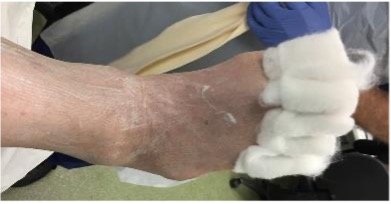
1. The entire leg is initially covered with an emollient cream.
2. Cotton wool is applied between the toes.
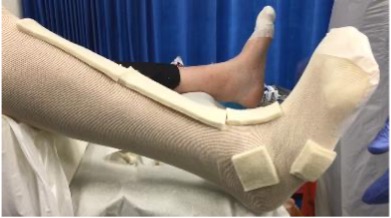
3. Stockinette is applied to cover the leg and toes. Semi-compressed felt is adhered over the bony prominences.
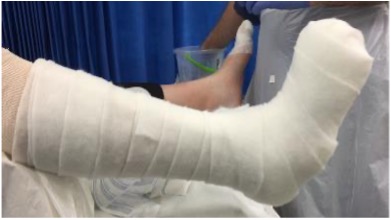
4. Cotton wool is wrapped round the leg and foot, including the toes.
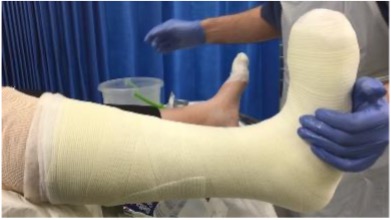
5. First layer of semi-conformable cast tape is applied to the leg and foot, not including the toes. The cast is well moulded throughout. Care is taken to ensure the ankle is in a neutral position.
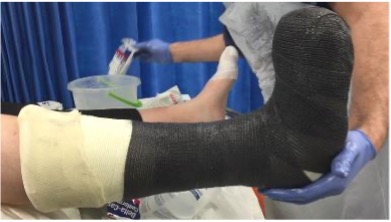
6. Second layer of cast tape is applied to the toe part and the rest of the leg. The stockinette is folded back over.
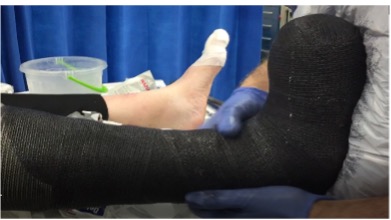
7. The third layer of cast tape is applied with additional reinforcement around the ankle region. The cast is allowed to dry and set before weight bearing is allowed.
8. The cast is changed frequently (usually weekly initially) until the changes in leg volume stabilise.
When not to consider a TCC !!
Significant ischemia: it is important to liaise with the vascular team before applying a TCC in the presence of significant ischemia
Active foot infection: this warrants active monitoring and frequent inspections and therefore it is not recommended to use a fixed TCC; a bi-valved TCC is a safe alternative
Marked instability:
- often due to acute Charcot or non-union of fractures
- TCC may not provide adequate stability against movement of the fragments
- can result in blistering and ulceration
- if used in the presence of instability, strict non-weight bearing should be enforced
Alternatives to TCC
Several RCTs have shown TCC outperforming removable devices both in healing rates and time to healing of diabetic foot ulcers. Removable, fixed angled, full leg length, offloading devices may be considered if the patient cannot tolerate a TCC and if the foot shape is relatively normal. Patients’ compliance and adherence to offloading regimes can be unpredictable with removable braces and may result in delayed bone healing or treatment failures.
References
Bates M, Jemmott T, and Edmonds ME. Chapter: Total Contact Casting. ‘Limb Salvage of the Diabetic Foot – An Interdisciplinary Approach’. ISBN 978-3-319-17917-9, ISBN 978-3-319-17918-6 (eBook), https://doi.org/10.1007/978-3-319-17918-6 (Springer 2019).
Wertsch JJ, Frank LW, Zhu H, Price MB, Harris GF, Alba HM. Plantar pressures with total contact casting. J Rehabil Res Dev. 1995;32(3):205–9.
Armstrong DG, Nguyen HC, Lavery LA, van Schie CH, Boulton AJ, Harkless LB. Off-loading the diabetic foot wound: a randomized clinical trial. Diabetes Care. 2001;24:1019–22.